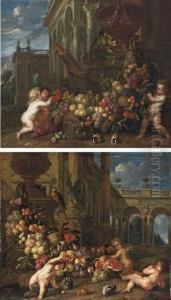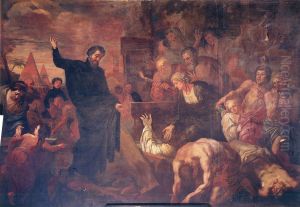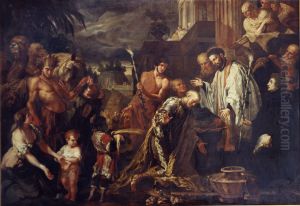Peter Ykens Paintings
Peter Ykens was a Flemish painter born in Antwerp in 1648, a period marked by the rich artistic tradition of the Southern Netherlands during the Dutch Golden Age. Despite the political and religious turmoil of the 17th century, which included the Eighty Years' War leading to the separation of the Northern and Southern Netherlands, the region continued to be a vibrant center for artistic production and innovation. Ykens grew up in this environment, which undoubtedly influenced his development as an artist.
Ykens was primarily known for his skill in painting still lifes, portraits, and religious subjects. His work exemplifies the Flemish Baroque style, characterized by its emphasis on vivid detail, rich color, and dramatic light and shadow. He was adept at creating deeply textured surfaces that gave his still lifes a tangible presence, and his portraits captured the subtle nuances of personality and status of his subjects. His religious paintings, on the other hand, reflected the Counter-Reformation's influence on art, aiming to inspire piety and devotion through their emotional depth and visual appeal.
Throughout his career, Ykens received commissions from various patrons, including religious institutions and members of the nobility, which was a testament to his skill and reputation. Despite the competition from other talented artists of his time, Ykens managed to carve out a successful career. His works were appreciated for their meticulous attention to detail and their ability to convey the materiality of the world.
Ykens's contribution to the Flemish Baroque tradition was significant, yet many details of his life and career remain less well-known compared to his contemporaries like Peter Paul Rubens or Anthony van Dyck. This relative obscurity may be due in part to the vast output of art in this period, which has made it challenging for all but the most exceptional artists to stand out in historical accounts. However, his surviving works continue to be studied and appreciated for their beauty and technical mastery.
Peter Ykens died in 1695 in Antwerp. His legacy is preserved in the collections of various museums and galleries, where his paintings continue to be admired for their intricacy and the glimpse they offer into the rich artistic culture of 17th-century Flanders. Ykens's work remains a testament to the enduring appeal of the Flemish Baroque style and its capacity to capture both the tangible and ephemeral aspects of life.


